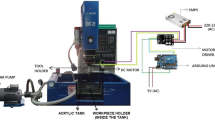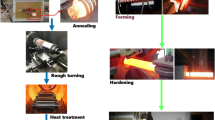Abstract
Only a few studies are conducted to change a non-conventional die-sinking electric discharge to sustainable machining of hard materials with intricate geometries, for which economic or environmental aspects need to be considered. Sustainable machining of such a hard material is a challenge nowadays. This research aims to achieve sustainable manufacturing of an electric discharge machining of AISI D2 steel using nanofluids. Graphene nanoplatelets mixed with kerosene oil were used as nanofluids. Sustainability is achieved through economic and environmental factors, which mainly include productivity (material removal rate), surface quality (surface roughness and white layer), and cost (overhead, electricity, nanofluids, and wasted coolant), as well as the environment (discharge energy and material consumptions). A sustainability framework is developed to prioritize the significant factors related to green manufacturing and compare the alternatives. A total of nine factors are grouped into four categories: productivity, surface defects, cost analysis, and environmental impacts are selected for the study. The effect of the four most influencing factors, pulse-off time, discharge current, pulse-on time, and concentration of nanoparticles with respect to sustainable performance measures, are investigated. The results depict that surface defects, such as surface roughness and white layer, are significant factors, followed by productivity and cost (overhead, electricity, nanofluids, and wasted coolant). The results show that the environmental aspect of sustainable manufacturing is less important than the others at the early stages as per experimental data and expert opinions. For international certifications, both economic and environmental aspects should be addressed as per international standards.














Similar content being viewed by others
Availability of data and material
The required data is included in the manuscript.
References
Chakraborty S, Dey V, Ghosh S (2015) A review on the use of dielectric fluids and their effects in electrical discharge machining characteristics. Precis Eng 40:1–6
Shinde R, Patil N, Raut D, Pawade R, Brahmaknakr P (2016) Experimental investigations into powder-mixed electrical discharge machining (Pmedm) of Hchcr D2 die steel. in International conference on communication and signal processing 2016 (ICCASP 2016). Atlantis Press: p. 298–303
Kolli M, Kumar A (2015) Effect of dielectric fluid with surfactant and graphite powder on electrical discharge machining of titanium alloy using Taguchi method. Engineering Science and Technology, an International Journal 18(4):524–535
Toshimitsu R, Okada A, Kitada R, Okamoto Y (2016) Improvement in surface characteristics by Edm with chromium powder mixed fluid. Procedia CIRP 42:231–235
Hanif M, Wasim A, Hussain S, Jahanzaib M (2019) Investigation of effects of dielectric type and polarity on electric discharge machining of Aisi D2 steel using response surface methodology. NED Univ J Res 16:81–93. https://doi.org/10.35453/NEDJR-ASCN-2018-0029
Özerinç S, Yazıcıoğlu A, Kakaç S (2012) Numerical analysis of laminar forced convection with temperature-dependent thermal conductivity of nanofluids and thermal dispersion. Int J Therm Sci 62:138–148
Singh R, Dureja JS, Dogra M, Gupta MK, Mia M (2019) Influence of graphene-enriched nanofluids and textured tool on machining behavior of Ti-6al-4v alloy. Int J Adv Manuf Technol 105(1):1685–1697. https://doi.org/10.1007/s00170-019-04377-8
Jayal A, Badurdeen F, Dillon O, Jawahir I (2010) Sustainable manufacturing: modeling and optimization challenges at the product, process and system levels. CIRP J Manuf Sci Technol 2(3):144–152
Paswan K, Pramanik A, Chattopadhyaya S, Basak AK (2020) A novel approach towards sustainable electrical discharge machining of metal matrix composites (Mmcs). Int J Adv Manuf Technol 106(3):1477–1486. https://doi.org/10.1007/s00170-019-04816-6
Dornfeld D (2014) Sustainability of machining. In Cirp encyclopedia of production engineering. Springer. p. 1204–1207
Deiab I (2014) On energy efficient and sustainable machining through hybrid processes. Mater Manuf Process 29(11–12):1338–1345. https://doi.org/10.1080/10426914.2014.921706
Yildiz Y, Nalbant M (2008) A review of cryogenic cooling in machining processes. Int J Mach Tools Manuf 48(9):947–964
Gayretli A, Abdalla H (1999) A prototype constraint-based system for the automation and optimization of machining processes. Proceedings of the Institution of Mechanical Engineers, Part B: J Eng Manuf 213(7):655–676. https://doi.org/10.1243/0954405991517100
Hanafi I, Khamlichi A, Cabrera FM, Almansa E, Jabbouri A (2012) Optimization of cutting conditions for sustainable machining of Peek-Cf30 using tin tools. J Clean Prod 33:1–9
Kellens K, Dewulf RW, Duflou JR (2011) Preliminary environmental assessment of electrical discharge machining. In Proceedings of the 18th CIRP international conference on life cycle engineering. Berlin, Heidelberg: Springer Berlin Heidelberg: p. 377–382. https://doi.org/10.1007/978-3-642-19692-8_65
Abbas NM, Yusoff N, Mahmod R (2012) Electrical discharge machining (Edm): practices in Malaysian industries and possible change towards green manufacturing. Procedia Engineering 41:1684–1688
Liu Y, Zhang Y, Ji R, Cai B, Wang F, Tian X, Dong X (2013) Experimental characterization of sinking electrical discharge machining using water in oil emulsion as dielectric. Mater Manuf Processes 28(4):355–363
Sivapirakasam S, Mathew J, Surianarayanan M (2011) Constituent analysis of aerosol generated from die sinking electrical discharge machining process. Process Saf Environ Prot 89(2):141–150
Ray A (2015) Multi-objective optimization of green Edm: an integrated theory. J Inst Eng (India): C 96(1):41–47
El-Hofy H, Youssef H (2009) Environmental hazards of nontraditional machining. in IASME/WSEAS International Conference on ENERGY & ENVIRONMENT (EE’09). p. 140–145
Hanif M, Wasim A, Shah AH, Noor S, Sajid M, Mujtaba N (2019) Optimization of process parameters using graphene-based dielectric in electric discharge machining of Aisi D2 steel. Int J Adv Manuf Syst 103(9):3735–3749
Carvalho G, Galvão I, Mendes R, Leal R, Loureiro A (2018) Influence of base material properties on copper and aluminium–copper explosive welds. Sci Technol Weld Joining 23(6):501–507
Tkalya E, Ghislandi M, Alexeev AA, Koning C, Loos J (2010) Latex-based concept for the preparation of graphene-based polymer nsanocomposites. J Mater Chem 20. https://doi.org/10.1039/b922604d
Evans S, Rana P, Short S (2012) State-of-practice in business modelling and value-networks, emphasising potential future models that could deliver sustainability. SustainValue Project Deliverable 2
Grassl W (2012) Business models of social enterprise: a design approach to hybridity. ACRN Journal of entrepreneurship Perspectives 1(1):37–60
Moldavska A, Welo T (2016) Development of manufacturing sustainability assessment using systems thinking. Sustainability 8(1):5
Zhang H, Calvo-Amodio J, Haapala KR (2015) Establishing foundational concepts for sustainable manufacturing systems assessment through systems thinking. International Journal of Strategic Engineering Asset Management 2(3):249–269
Chow H-M, Yan B-H, Huang F-Y, Hung J-C (2000) Study of added powder in kerosene for the micro-slit machining of titanium alloy using electro-discharge machining. J Mater Process Technol 101(1–3):95–103
European Commision (EC) (2006) Action Plan for Energy Efficiency: Realising the Potential. COM (2006) 545, EC, Brussels.
Davim JP (2010) Sustainable manufacturing. London; Hoboken, NJ: ISTE ; John Wiley
Ahmad W (2012) Cost modelling system for lean product and process development
Westkämper E (2008) Manufuture and sustainable manufacturing, in Manufacturing systems and technologies for the new frontier. Springer. p. 11–14
Pusavec F, Krajnik P, Kopac J (2010) Transitioning to sustainable production–part I: application on machining technologies. J Clean Prod 18(2):174–184
Valaki JB, Rathod PP, Khatri BC (2015) Environmental impact, personnel health and operational safety aspects of electric discharge machining: a review. Proc Inst Mech Eng B J Eng Manuf 229(9):1481–1491. https://doi.org/10.1177/0954405414543314
Jasiulewicz-Kaczmarek M, Legutko S, Kluk P (2020) Maintenance 4.0 technologies–new opportunities for sustainability driven maintenance. Manag Prod Eng Rev 11
Slorach PC, Jeswani HK, Cuéllar-Franca R, Azapagic A (2020) Assessing the economic and environmental sustainability of household food waste management in the Uk: current situation and future scenarios. Sci Total Environ 710:135580
Acknowledgements
The authors would like to acknowledge the support provided by the Wuhan National Laboratory of Optoelectronics (WNLO) and Huazhong University of Science and Technology, Wuhan, China, by providing the material testing facility. The authors would also like to acknowledge Ms. Bettina Mauser, Germany, for English proofreading.
Funding
This work was financially supported by the National Key R&D Programs of China (Number: 2019YFB1311100) and the Open Topics of State Key Lab of Digital Manufacturing Equipment & Technology of Huazhong University of Science and Technology (Number: DMETKF2020003).
Author information
Authors and Affiliations
Corresponding author
Ethics declarations
Ethics approval
This work does not involve human ethical issues. Moreover, we promise to follow the COPE guidelines on how to deal with potential acts of misconduct.
Consent for publication
All the authors have agreed to publish this manuscript.
Conflict of interest
The authors declare no competing interests.
Additional information
Publisher's Note
Springer Nature remains neutral with regard to jurisdictional claims in published maps and institutional affiliations.
Rights and permissions
About this article
Cite this article
Hanif, M., Zhang, L. & Ahmad, W. Analysis of a novel sustainability framework based on economic and environmental aspects in graphene-based dielectric electric discharge machining. Int J Adv Manuf Technol 119, 6287–6306 (2022). https://doi.org/10.1007/s00170-021-08548-4
Received:
Accepted:
Published:
Issue Date:
DOI: https://doi.org/10.1007/s00170-021-08548-4




